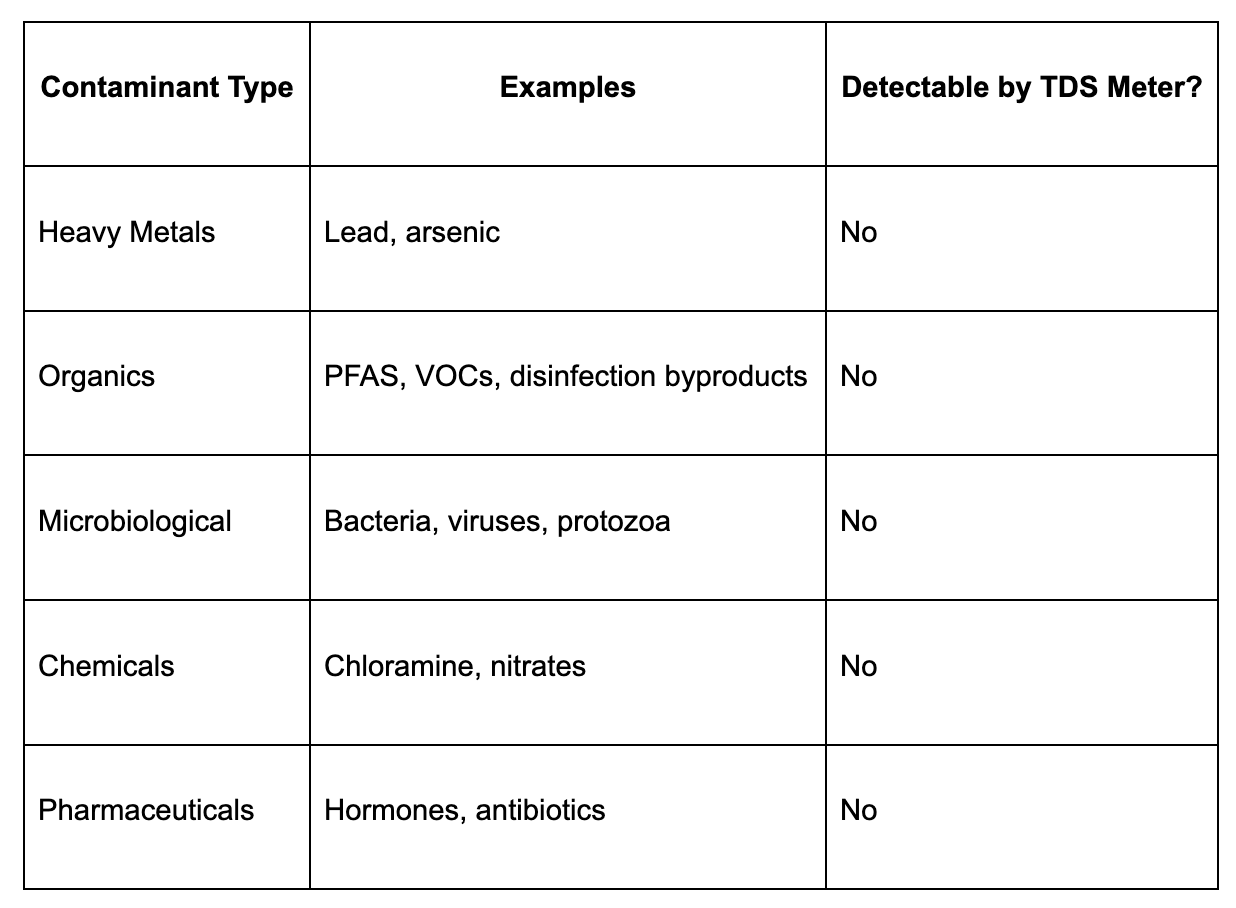What TDS Meters Miss (Even When ZeroWater Hits 0)

%20.png)
Content
The Truth About TDS Meters on ZeroWater: What You’re Not Seeing
ZeroWater is a popular choice among consumers for its ability to bring Total Dissolved Solids (TDS) down to zero. When a user sees “000” on a TDS meter, it often creates the impression that their water is completely clean and safe. While this sounds ideal, it can be dangerously misleading.
TDS (Total Dissolved Solids) meters measure the electrical conductivity of water caused by dissolved ions like calcium or sodium. While ZeroWater filters are effective at reducing TDS to 0 ppm, this reading only confirms the absence of dissolved solids, not harmful contaminants.
TDS meters cannot detect:
- PFAS (forever chemicals)
- Lead and arsenic
- Pharmaceuticals
- Bacteria or viruses
- VOCs and chlorine byproducts
A zero TDS reading does not mean water is free from toxic substances. Consumers often assume 0 TDS = clean water, but health-based threats may still be present.
ZeroWater’s technology removes total solids, but to ensure actual water safety, users should rely on:
- NSF-certified filters (NSF-53, NSF-58)
- Lab-tested performance
- Platforms like H2OScore, which evaluate contaminant removal beyond conductivity
TDS: What It Measures vs What It Misses
TDS meters quantify the level of charged inorganic particles (like salts or minerals) dissolved in your water. The number is expressed in parts per million (ppm) and reflects how conductive the water is.
This might help detect hard water or general mineral load, but it tells you nothing about invisible health hazards like volatile organics, chemical byproducts, or microbial risks.
Why ZeroWater Shows 0 TDS—But That Doesn’t Mean Safety
ZeroWater filters use a five-stage ion exchange system that is effective at removing dissolved solids. That’s why their system frequently scores 0 on a TDS meter. But this zero only reflects the absence of minerals, not a guarantee of purity.
Many harmful contaminants do not affect electrical conductivity, including:
- PFAS
- Pesticides
- Pharmaceuticals
- Chloramines
- Endocrine-disrupting compounds
This means ZeroWater users may confidently drink water with 0 ppm, while still unknowingly consuming toxic substances.
Complaints: What Users Discover Too Late
Users often share concerns like:
- “My meter says 0, but the water still tastes fishy.”
- “TDS stayed at zero, but the filter was chemically exhausted.”
- “Do I need to replace the filter even though the meter says it's fine?”
The problem is rooted in expectation: many consumers believe the TDS number equals purity, when it really reflects only solid load, not toxic exposure.
This is especially misleading for users in areas with industrial runoff, agricultural zones, or aging municipal infrastructure, where the water contains more than just minerals.
What TDS Meters Cannot Detect?

This table highlights why relying solely on TDS meters can lead to false reassurance.
A Better Way to Measure Water Safety
Instead of relying on TDS alone, users should look at:
- Lab-tested performance data for specific contaminants
- NSF certifications (NSF-53 or NSF-58) which cover lead, cysts, VOCs, and other toxins
- Platforms like H2OScore, which provide independent filter rankings based on actual lab results, not just mineral content
For example, systems like AquaTru or Bluevua use reverse osmosis combined with activated carbon, targeting a much wider array of threats than pitcher filters. You can compare them head-to-head with ZeroWater on H2OScore’s pitcher and under-sink filter rankings.
TDS meters offer a narrow picture. Water safety depends on lab-verified contaminant removal, something platforms like H2OScore are built to track.
Choosing the Right Filter for Safety, Not Just Taste
To ensure you're not relying on misleading signals:
- Choose filters with multi-stage purification (e.g., carbon block + sediment + RO membrane)
- Look for NSF-53 or NSF-58 certification
- Check performance against contaminants in your local water report
- Use tools like the H2OScore app to evaluate filters based on chemical removal, not total solids
This helps bridge the gap between perceived and actual filtration, and avoids over-relying on incomplete tools like TDS meters.


